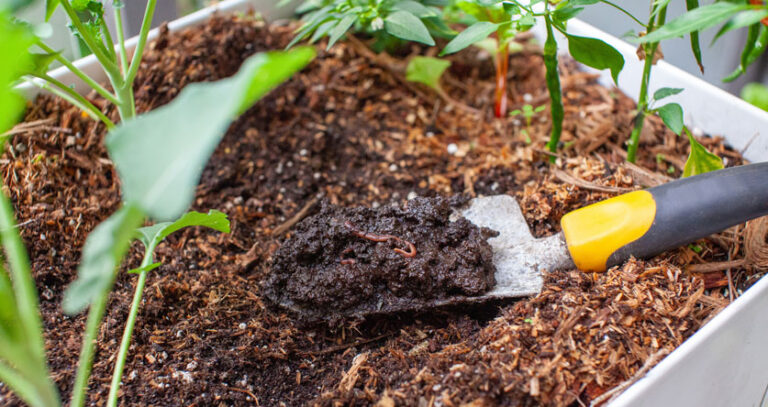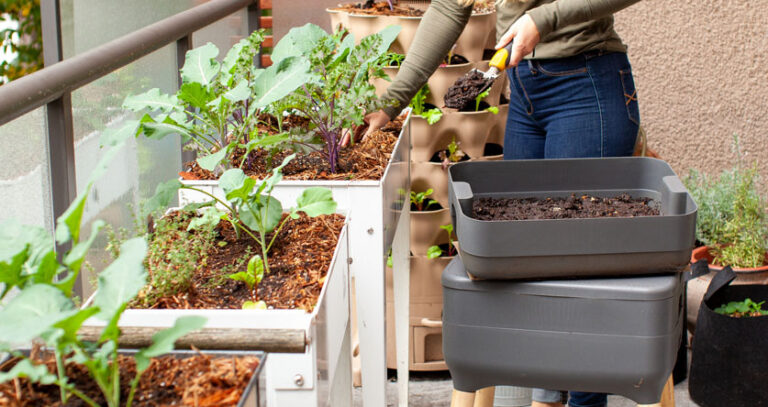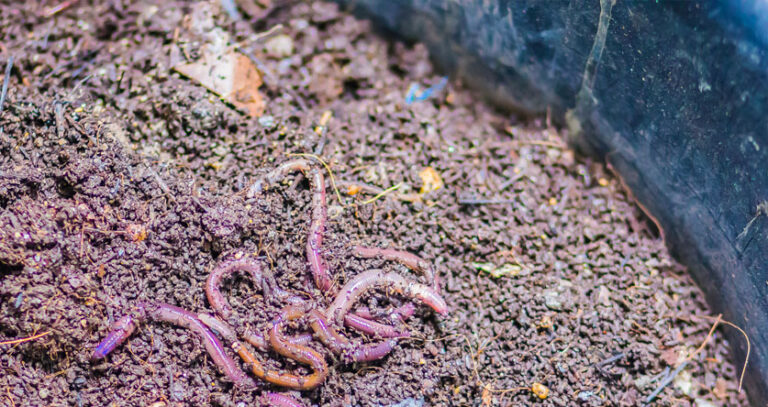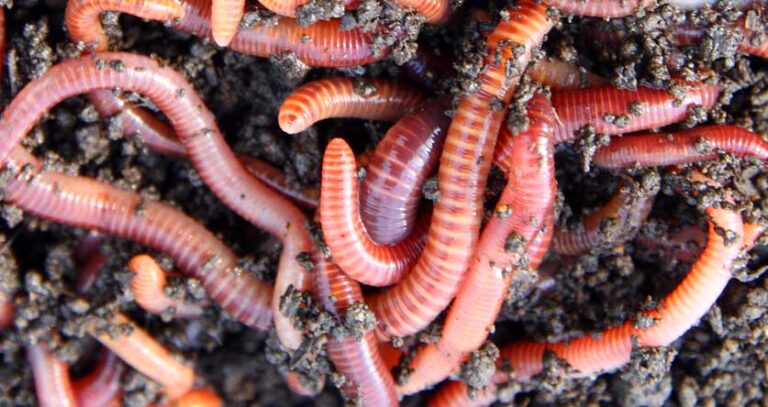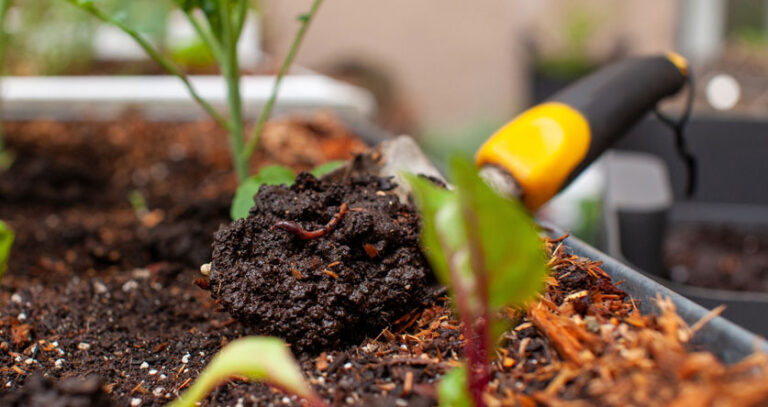Best Worms For Composting (Choosing the Right Species!)

Did you know there are more than 7000 worm species in the world?
You’d think they would all be okay for composting, but in North America, only four are commonly used.
Yep… Just four!
A worm’s size, the temperature they thrive in, and burrowing style are some of the reasons only a few worms are suitable.
So which types of worms should you use in your composting efforts? Below I’ll tell you all about the best worm species and what they will do for your compost.
What Type Of Worm Is Best For Composting?
The best and most versatile worms for composting and vermicomposting are Red Wigglers. They eat half their weight in compost daily and survive well in temperatures between 50-90⁰F (10-32°C). Other composting worms include Red Tigers, African Nightcrawlers, Indian Blue Worms, and Red Earthworms.
Red Wigglers

- Latin Name: Eisenia fetida (Also known as redworm, trout worm, manure worm, brandling worm, or panfish worm).
- Distinctive features: Red/light brown transverse bands between segments and yellowish tail.
- Average number of worms in a pound: 1000
- Preferred temperature range: between 55⁰F (13⁰C) – 88⁰F (31⁰C)
Red wigglers are great compost worms because they process as much as half their weight in organic matter daily. In nature, they can be found in decaying leaves, manure, and (lucky for us) compost piles! So these worms are ideal for processing organic matter in a vermicompost bin.
Red wigglers also tolerate handling, although they may let off a stinky smell (which is where they get their name: fetida=fetid) when handled roughly individually. They are also readily available online from worm farm suppliers and other agriculture stores.
However, red wigglers do not transfer well to the garden, so remove them before using your compost.
Red Tigers

- Latin Name: Eisenia andrei (Also known as red wiggler, redworm).
- Distinctive features: a darker red color than red wigglers with less pronounced stripes
- Average number of worms in a pound: 1000
- Preferred temperature range: between 55⁰F (13⁰C) – 88⁰F (31⁰C)
Red tigers are close relatives of red wigglers and are often confused or typed as the other. They share very similar characteristics and can even be interbred. Red tigers perform slightly better than their cousins, but in most cases, you can’t tell the difference.
Because they are so similar, you will often find red wigglers and red tigers mixed in the same bag even when ordering them, and most growers don’t separate them.
African Nightcrawlers

- Latin Name: Eudrilus eugeniae
- Distinctive features: longer than red wigglers with the clitellum closer to the head.
- Average number of worms in a pound: 300-350
- Preferred temperature range: between 77⁰F (25⁰C) – 95⁰F (35⁰C)
African nightcrawlers make excellent worms for compost, producing some of the best vermicasts of compost worms. There is one downside to African nightcrawlers, though, because they require a constantly high-temperature range to thrive, they are more difficult to cultivate and keep. This is the main reason more people choose red wigglers as their preferred composting worm!
Although they have become more common in recent years, African nightcrawlers are still often hard to find. Also, They are usually one of the most expensive composting worms on the market.
Indian Blue Worms

- Latin Name: Perionyx excavatus (Also known as blues, Malaysian blue, composting worms, or Indian blues).
- Distinctive features: similar in size and coloring to a red wiggler but slightly longer and thinner.
- Average number of worms in a pound: 800-900
- Preferred temperature range: between 68⁰F (20⁰C) – 95⁰F (35⁰C)
Indian blue worms have a high reproduction rate and require high temperatures but are more resilient than African nightcrawlers. One odd feature of these worms is that they can sometimes ‘flee’ the compost bin or heap because of changes in barometric pressure, a thunderstorm, or for no apparent reason!
Indian blue worms are often confused for red wigglers and are sometimes sold as such. Because they behave and look similar to red wigglers, you may not even know you have them until they all try to escape your compost bin!
Red Earthworms (Not For Composting)

- Latin Name: Lumbricus rubellus (Also known as dung worm, red marsh worm).
- Distinctive features: reddish brown or reddish violet in color and can grow between 0.98in (25mm) – 4.1in (105mm) in length
- Average number of worms in a pound: 300+
- Preferred temperature range: between 52⁰F (11⁰C) – 60⁰F (15⁰C)
Red earthworms are also sometimes confused for red wigglers because of their similar appearance. Still, they are not as suitable for composting as red wigglers, red tigers, African nightcrawlers, or Indian blue worms. Because of their slow maturation rate and reproductive rate, they are not ideal for composting.
However, because of their size, red earthworms make good fish bait! They are often sold as composting worms because they are readily available, but be careful to avoid buying them by mistake.
Red earthworms have become a pest in some places due to being released at fishing sites.
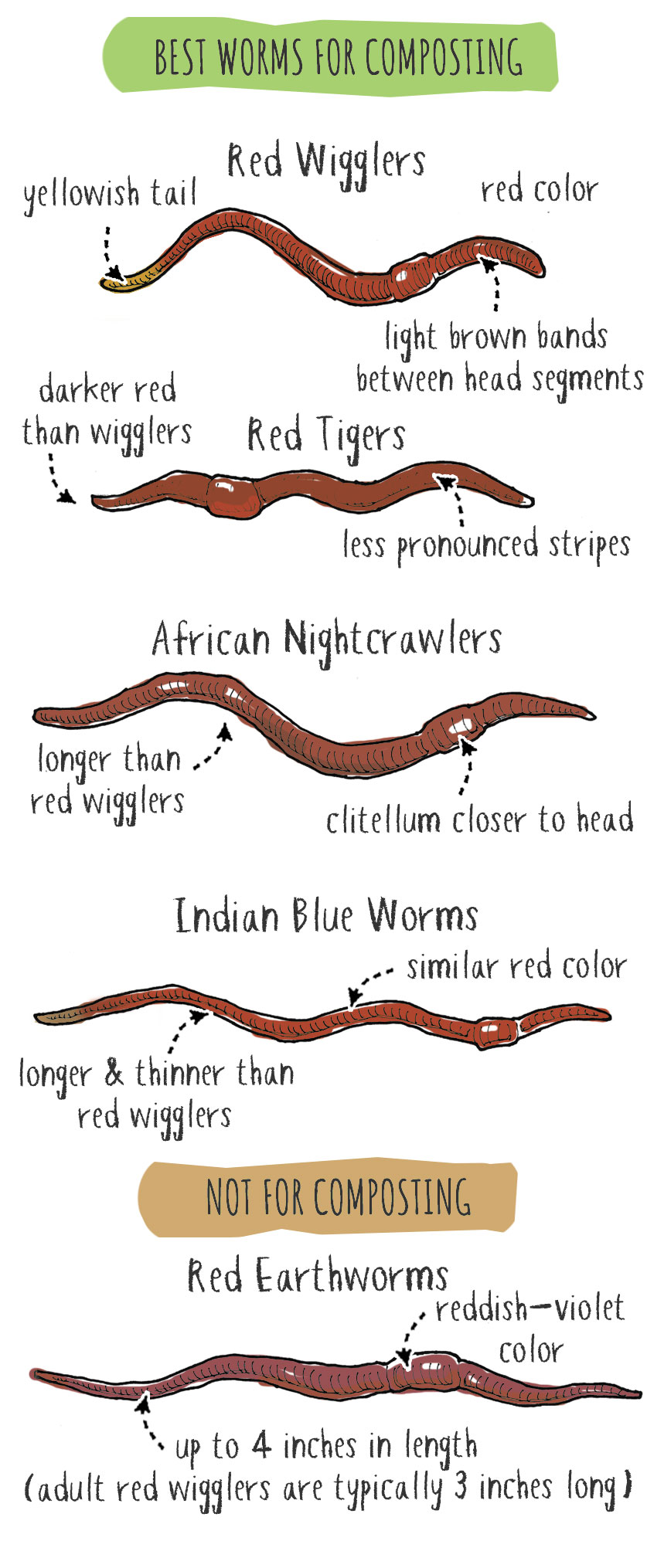
Can You Use Any Type Of Worms For Composting?
Unfortunately, you can’t simply use any type of worm for composting. This is because different kinds of worms have different eating and burrowing habits. Some worms burrow too deep and leave stuff on the surface to rot, while others may even try to pull food down into their hole. Neither of these kinds will work for composting.
All worms fall into one of the three categories in the table below. However, as you can see, only the Epigeic type are suitable composters :
| Type of worm | Body type | Burrowing style | Good for composting? | Name meaning |
| Anecic | Strong and muscular. | Vertical burrowers, up to a few feet deep. | No | Greek for ‘Out of the earth’. |
| Endogeic | Muscular, but smaller than anecic worms. | Vertical burrowers, up to six inches deep. | No | Greek for ‘In the earth’. |
| Epigeic | Least muscular and smaller than anecic or endogeicworms. | Surface worms. | Yes | Greek for ‘On the earth’. |
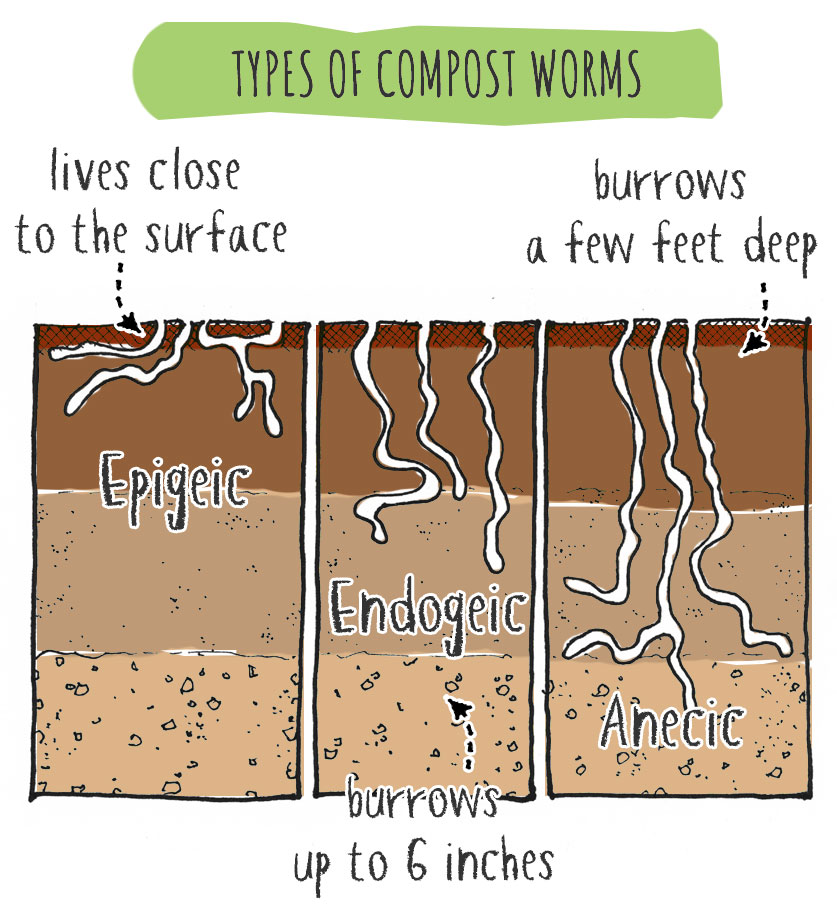
What you want for composting is a worm that stays on the surface and eats its way through composting material as quickly as possible. Even some species of epigeic worms are not necessarily good for composting because they don’t like living in large numbers in the confines of a compost container.
The four composting worms we discuss below all live well in a compost container and do a great job of vermicomposting.
What Is The Difference Between Garden Worms And Compost Worms?
So, you might be asking, “Can I take worms from the surface of my garden and use them for composting?” You might strike it lucky and get a red wiggler in your compost, but the chances are you’ll get another type of worm that will either die in the container or escape as soon as possible!
That’s because even though garden worms and compost worms are both segmented worms, they’re different species.
These are the main differences between garden worms and compost worms:
| Garden earthworm | Compost worms |
| Burrowing worm that lives below the surface(i.e. they need to be dug up to be discovered). Aerates the soil and pulls debris down into its burrow. | A surface-dwelling worm that lives underneath decaying organic matter but not in the soil. They do not burrow. |
| ¼ to 6 inches in length | 2 to 3 inches in length |
| Reddish-brown in color | Reddish-purple in color |
| Slow to reproduce | Quick to reproduce |
| Need space in the soil | Happy to live in close proximity to other worms |
Using The Right Kind Of Worms
Because different kinds of worms behave in different ways, reproduce at different rates, and prefer to burrow or stay on the surface, you will get better results if you use the right kind of worm in your compost.
Burrowing worms don’t like their burrows disturbed, so they’re unsuitable in compost bins that need turning. Anecic and endogeic worms also dislike living too close to other worms.
For successful composting, you need a worm that will:
- Live on the surface of the compost to eat new organic waste material,
- Doesn’t burrow so that turning the compost or removing some of it will not disturb them,
- Is happy to live in close proximity and large numbers in a confined space,
- Eats a lot and will quickly break down what’s in the compost,
- Reproduces easily and quickly.
Knowing what you want your compost worms to do and each worm’s best characteristics will help you see whether you’re using the right kind of worm for composting.
Can Different Types Of Worms Live Together?
In most cases, different worms can live together without domination between species. Some composters prefer to have more than one species in a worm bin or compost pile so that other worms can process organic matter at different depths and possibly process the compost better or quicker.
While they can live together, worms maximize reproduction and compost processing rates when they reach a specific population density.
So when you combine species in a single compost bin, you will often achieve the total worm population density for the bin but miss the mark for each species, making them both less efficient than if you just had one species in the bin!
Also, buying 2 lbs of one species is often cheaper than buying two 1 lbs bags of two different species.
How Many Worms Do I Need For My Vermicompost Bin?
For most vermicompost bins, ½-1 pound of composting worms will work well per square foot of bin space. The type of worm in your bin will affect this, red wigglers eat about half their weight in food per day, but others may eat more or less, use the weight of the worms as a guide for this.
So, to sum up, keep the following in mind:
- Only some worms can be used for composting.
- The best kind of worms is epigeic worms, as they stay on the surface of the compost.
- The red wiggler is the most hardy and commonly found composting worm, which many consider the best worm for composting.
- Other epigeic species like red tigers, African nightcrawlers, and Indian blue worms also make good composting worms.
Have fun with your wiggly friends 🙂


